Files in this item
Revolution evolution : tracing angular momentum during star and planetary system formation
Item metadata
| dc.contributor.advisor | Gregory, Scott | |
| dc.contributor.author | Davies, Claire L. | |
| dc.coverage.spatial | 234 | en_US |
| dc.date.accessioned | 2015-09-28T15:36:20Z | |
| dc.date.available | 2015-09-28T15:36:20Z | |
| dc.date.issued | 2015-11-30 | |
| dc.identifier | uk.bl.ethos.667519 | |
| dc.identifier.uri | https://hdl.handle.net/10023/7557 | |
| dc.description.abstract | Stars form via the gravitational collapse of molecular clouds during which time the protostellar object contracts by over seven orders of magnitude. If all the angular momentum present in the natal cloud was conserved during collapse, stars would approach rotational velocities rapid enough to tear themselves apart within just a few Myr. In contrast to this, observations of pre-main sequence rotation rates are relatively slow (∼ 1 − 15 days) indicating that significant quantities of angular momentum must be removed from the star. I use observations of fully convective pre-main sequence stars in two well-studied, nearby regions of star formation (namely the Orion Nebula Cluster and Taurus-Auriga) to determine the removal rate of stellar angular momentum. I find the accretion disc-hosting stars to be rotating at a slower rate and contain less specific angular momentum than the disc-less stars. I interpret this as indicating a period of accretion disc-regulated angular momentum evolution followed by near-constant rotational evolution following disc dispersal. Furthermore, assuming that the age spread inferred from the Hertzsprung-Russell diagram constructed for the star forming region is real, I find that the removal rate of angular momentum during the accretion-disc hosting phase to be more rapid than that expected from simple disc-locking theory whereby contraction occurs at a fixed rotation period. This indicates a more efficient process of angular momentum removal must operate, most likely in the form of an accretion-driven stellar wind or outflow emanating from the star-disc interaction. The initial circumstellar envelope that surrounds a protostellar object during the earliest stages of star formation is rotationally flattened into a disc as the star contracts. An effective viscosity, present within the disc, enables the disc to evolve: mass accretes inwards through the disc and onto the star while momentum migrates outwards, forcing the outer regions of the disc to expand. I used spatially resolved submillimetre detections of the dust and gas components of protoplanetary discs, gathered from the literature, to measure the radial extent of discs around low-mass pre-main sequence stars of ∼ 1−10 Myr and probe their viscous evolution. I find no clear observational evidence for the radial expansion of the dust component. However, I find tentative evidence for the expansion ofthe gas component. This suggests that the evolution of the gas and dust components of protoplanetary discs are likely governed by different astrophysical processes. Observations of jets and outflows emanating from protostars and pre-main sequence stars highlight that it may also be possible to remove angular momentum from the circumstellar material. Using the sample of spatially resolved protoplanetary discs, I find no evidence for angular momentum removal during disc evolution. I also use the spatially resolved debris discs from the Submillimetre Common-User Bolometer Array-2 Observations of Nearby Stars survey to constrain the amount of angular momentum retained within planetary systems. This sample is compared to the protoplanetary disc angular momenta and to the angular momentum contained within pre-stellar cores. I find that significant quantities of angular momentum must be removed during disc formation and disc dispersal. This likely occurs via magnetic braking during the formation of the disc, via the launching of a disc or photo-evaporative wind, and/or via ejection of planetary material following dynamical interactions. | en_US |
| dc.language.iso | en | en_US |
| dc.publisher | University of St Andrews | |
| dc.rights | Creative Commons Attribution-NonCommercial-NoDerivatives 4.0 International | |
| dc.rights.uri | http://creativecommons.org/licenses/by-nc-nd/4.0/ | |
| dc.subject | Star formation | en_US |
| dc.subject | Planet formation | en_US |
| dc.subject | Protoplanetary discs | en_US |
| dc.subject | Circumstellar material | en_US |
| dc.subject | Submillimetre astronomy | en_US |
| dc.subject | Angular momentum | en_US |
| dc.subject.lcsh | Stars--Formation | en_US |
| dc.subject.lcsh | Planets--Origin | en_US |
| dc.subject.lcsh | Protoplanetary disks | en_US |
| dc.subject.lcsh | Circumstellar matter | en_US |
| dc.subject.lcsh | Submillimeter astronomy | en_US |
| dc.subject.lcsh | Angular momentum | en_US |
| dc.title | Revolution evolution : tracing angular momentum during star and planetary system formation | en_US |
| dc.type | Thesis | en_US |
| dc.type.qualificationlevel | Doctoral | en_US |
| dc.type.qualificationname | PhD Doctor of Philosophy | en_US |
| dc.publisher.institution | The University of St Andrews | en_US |
This item appears in the following Collection(s)
Except where otherwise noted within the work, this item's licence for re-use is described as Creative Commons Attribution-NonCommercial-NoDerivatives 4.0 International
Items in the St Andrews Research Repository are protected by copyright, with all rights reserved, unless otherwise indicated.


